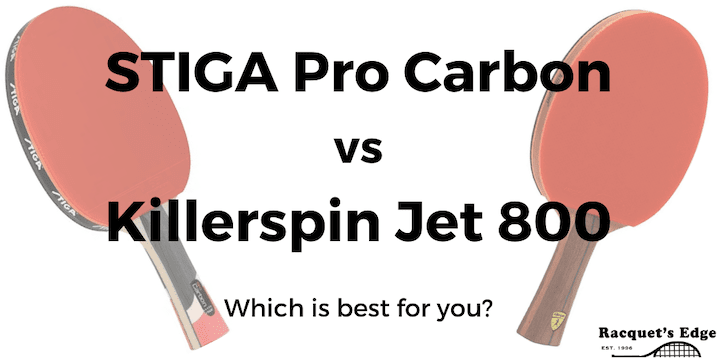
Choosing the best ping pong paddle can be tough. But it looks like you’ve narrowed it down to two excellent options: the Stiga Pro Carbon paddle, and the Killerspin Jet 800.
Both bats have their strengths and weaknesses, but the right paddle choice really comes down to you as a table tennis player, and what complements your style of play.
Keep reading for an advanced comparison of STIGA Pro Carbon vs Killerspin Jet 800. We’re going to go deep and compare each element, from blade construction to rubber and handle type. We’ll also discuss price, the brands and the playing style and level of play these bats are recommended for.
Let’s get to it.
Quick answer: which is better – STIGA Pro Carbon or Killerspin Jet 800?
Go for the STIGA Pro Carbon table tennis paddle if you want a compact lightweight bat with carbon blade. It’s better designed for speed and close-to-table play.
Go for the Killerspin Jet 800 table tennis paddle if you want a larger, heavier bat with carbon blade. It’s better suited for power and control, and offensive, aggressive play styles.
Both paddles are IFTT-approved, and suitable for competition use. They both have 7-ply wood and carbon blades, and are ideal for intermediate or advanced players.
Price comparison
The STIGA Pro Carbon and Killerspin Jet 800 bats can usually be bought for around the same price.
Here are the latest prices for each paddle on Amazon:
| Photo | Paddle | Price | Buy |
|---|---|---|---|
 Top
Top | STIGA Pro Carbon | Buy on Amazon | |
 Top
Top | Killerspin Jet 800 | Buy on Amazon |
Size comparison
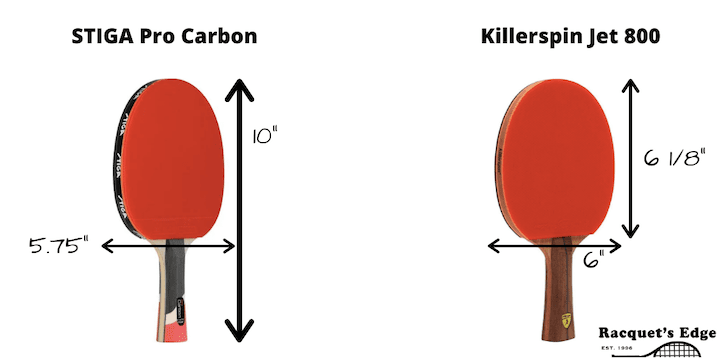
The biggest difference between the STIGA Pro Carbon and the Killerspin Jet 800 is size. The Killerspin Jet 800 is a larger bat than the STIGA Pro Carbon.
The Killerspin Jet 800 paddle head measures 6 inches wide, and 6 1/8 inches long (152 by 156mm).
The STIGA Pro Carbon bat measures 10 inches in total length, with a head width of 5.75 inches.
As you may know, according to IFTT (International Table Tennis Federation) rules:
a ping pong paddle can be any size, and shape or any weight, as long as the blade is flat and rigid.
That means you can use any bat size you like, even in official competitions.
Is a bigger table tennis paddle better?
It depends on you, as a player. If you have large hands, then you may find it easier to grip a larger paddle, like the Killerspin Jet 800.
However, larger bats will inevitably weigh more (see more about weight below), which will slow down your play a little.
Larger paddles = Larger margin of error, heavier, slower, increased ball dwell time
Smaller paddles = Faster, easier to handle
If you’re a beginner or intermediate player, you’ll probably find a smaller paddle, like the STIGA Pro Carbon, easier to maneuver and play with.
If you’re upgrading an old paddle, it’s a good idea to stick with a similar size – changing paddle size will take time to get used to.
Note: You may have noticed that on Amazon the STIGA Pro Carbon is incorrectly listed as 21.5 inches long – this is completely incorrect! [If you read a review of the Pro Carbon and they say it’s 21.5 inches, you know they’ve just copy/pasted the Amazon description without actually knowing anything about table tennis!]
Weight comparison
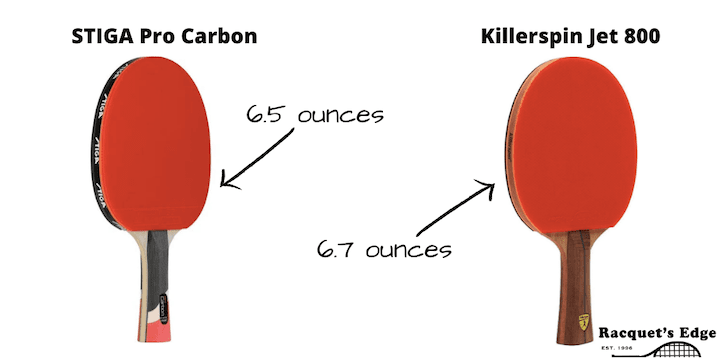
The STIGA Pro Carbon is a lighter paddle than the Killerspin Jet 800.
The STIGA Pro Carbon weighs 185g (6.5 ounces), which is in part due to the hollowed out handle (more on that below).
The Killerspin Jet 800 weighs 190g (6.7 ounces).
5g is a small amount of difference, but could still affect your play.
Carbon paddles (as these both are), are generally heavier than 100% wood paddles. If you’re looking for a lighter bat, you won’t find much lighter than 170g (the weight of the Butterfly Timo Boll racket, which is 100% wood).
A lightweight table tennis paddle isn’t necessarily better, and can be harder to control and lacks power. Of course, it’s easier to add weight to your paddle (i.e. by using power tape) than remove it.
In general, lightweight paddles are better for:
- speed
- close-to-the-table play
- good backhand/forehand transition
Heavier paddles, therefore, give you increased:
- power
- control
Don’t forget to read more below about how STIGA uses a different handle design to alter the center of gravity in the Pro Carbon to see if it suits you.
Blade comparison
Both the STIGA Pro Carbon and Killerspin Jet 800 have 7-ply blades, with a mix of wood and carbon. There’s not a lot of difference between them.
As we discussed in our table tennis paddle guide,
To be competition standard, a table tennis blade must be at least 85% wood, and additional materials must be less than 7.5% of the total thickness or 0.35mm, whichever is smaller.
This is in compliance with IFTT rules. If you’re playing recreationally, you don’t need to make blade choices based on the 85% wood rule, although you’ll find that most paddles on the market are in compliance.
As carbon is more uniform and rigid than wood, blades with carbon layers help increase:
- precision
- uniform bounce
- stability
- speed
The flipside is that carbon blades allow for less control.
According to Killerspin, the Jet 800 is suited to aggressive play:
Killerspin’s professional quality blade construction with 7-ply composite wood and carbon fiber mean enhanced accuracy and extra pop for an aggressive play style.
Whereas STIGA describes the Pro Carbon paddle as ideal for advanced players:
STIGA Pro Carbon is the perfect racket for the advanced player looking to take their game to the next level with exceptional speed, spin, and control ratings.
Rubber comparison
The STIGA Pro Carbon uses S5 rubber, and the Killerspin Jet 800 uses Nitrx-4Z rubber. These names don’t mean much, because they are simply brand names developed by the companies themselves.
The IFTT has a list of over 1600 approved rubber table tennis coverings, and STIGA’s S5 and Killerspin’s Nitrx-4Z are both on it, which means they are approved for use in tournaments.
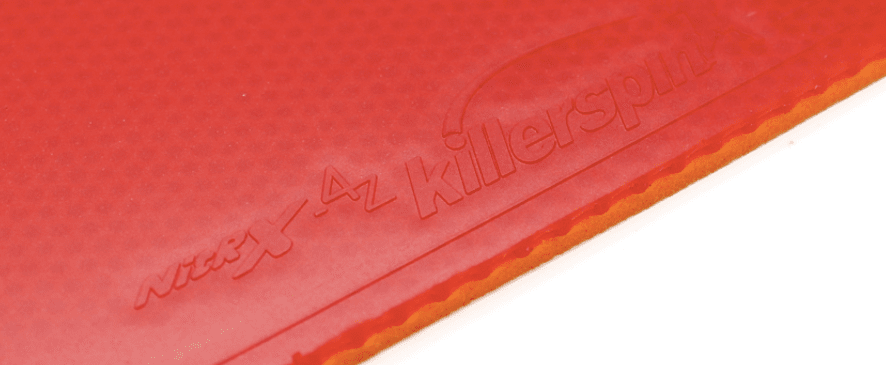
Here’s what Killerspin says about the Nitrx-4Z rubber:
The tacky but thin topsheet on Nitrx 4z gives you the advantage of heavy spin on serves, while being more forgiving when receiving spinny shots. High control is offered for blocks and counters. Nitrx 4z is suited for a power driving offense, and works well in a third-ball attack game. Made in China. ITTF approved.
You can buy replacement Nitrx-4Z rubber if required.
Despite being known for manufacturing multiple types of rubber STIGA’s “s5 rubber” is not available for sale separately, however you can replace the rubber on the Pro Carbon with anything you like.
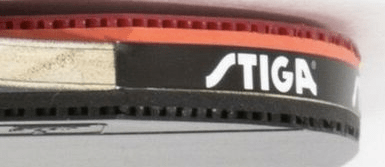
The rubber on the STIGA Pro Carbon is known as sandwich rubber, which includes 2mm of sponge plus pimpled rubber.
Thicker sponge = More speed
As Killerspin’s Nitrx-4Z rubber is also a similar type of sandwich rubber, measuring 2.1mm thick.
Both paddles are black on one side and red on the other – but the rubber is identical on both sides. The color difference is there to remain complaint with IFTT rules.
There’s very little difference between the rubber used on the STIGA Pro Carbon and the Killerspin Jet 800 – both are quite fast rubbers, so better suited to intermediate or experienced players.
Handle comparison
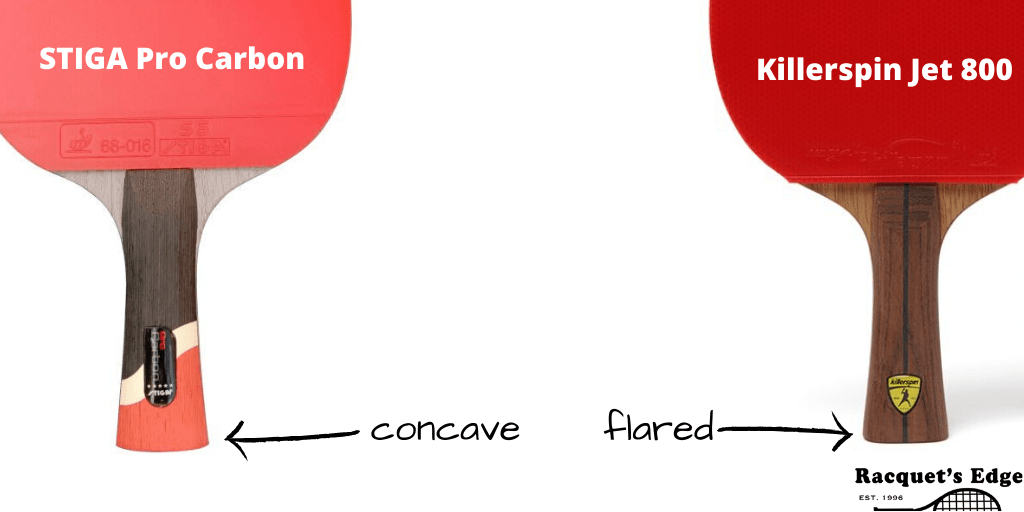
As you can see, there’s very little visible difference between the handles of the STIGA Pro Carbon and Killerspin Jet 800.
Killerspin Jet 800 has a flared handle.
STIGA Pro Carbon is described as having a “concave” handle, which is just another way of saying flared.
Flared handles help keep the paddle in your hand during fast play, and are excellent for:
- Comfort
- Grip
However, the STIGA Pro Carbon has an extra feature that the Killerspin Jet 800 lacks: a WRB handle.
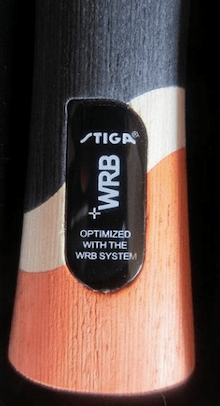
What is WRB?
WRB stand for Weight Recovery Balance. In short, it’s a hollow cut-out that makes the handle super lightweight, and shifts the center of gravity to the head of the blade.
There is debate as to whether WRB improves play or not, and it really comes down to your preferences.
Handle construction
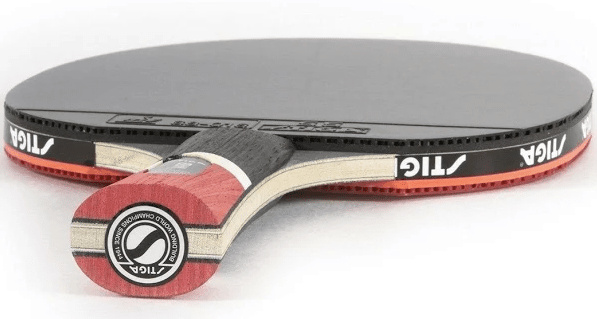
Another secret lying in the STIGA Pro Carbon handle is something they call a Shock Dispersion Tube (SDT).
The SDT is designed to absorb vibrations and transfer energy out of the handle.
The handle of the Killerspin Jet 800 is solid wood.
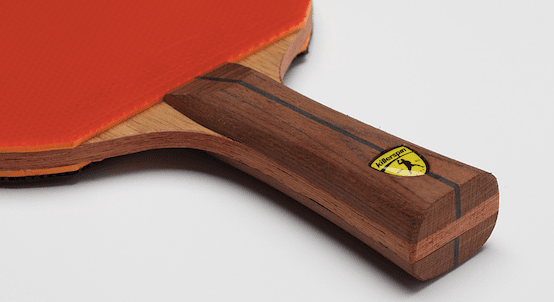
In terms of how they feel in your hand, both handles are very similar, and you can always add soft grip tape for additional comfort.
STIGA vs Killerspin: Which brand is better?
We like to know the story behind the brands we buy, especially when it comes to buying sports equipment that needs to be perform at a high level.
Here’s an overview of STIGA and Killerspin as companies and brands so you can see which one is a better fit for you.
A quick history of the STIGA table tennis brand
STIGA Sports, part of the Stiga Group, is a European producer of sporting goods, best known for its table tennis range. STIGA has been producing table tennis bats since 1944 (source).

All STIGA blades are still manufactured in Sweden, for quality control, and they source rubber from Germany. You can buy ready-made STIGA paddles, like the STIGA Pro Carbon, or buy individual blades and rubber and make your own custom bat.

A short history of the Killerspin table tennis brand
Killerspin was founded in 2001 by entrepreneur Robert Blackwell Jr. after sponsoring a ping pong festival the year before (source).
While working on promoting Killerspin in 2016, Robert Blackwell Jr. presented Pope Francis with a ping pong paddle and customized table tennis table for the Vatican (source).

Unlike STIGA, Killerspin is much more of a lifestyle table tennis brand. They sell a range of table tennis tables, paddles, balls and cases. Killerspin also sell a range of custom ping pong tables with scenic images printed on them. While they definitely look awesome at home, these tables help make it clear why Killerspin is not a popular choice with table tennis professionals.
Final verdict: which is better, STIGA Pro Carbon or Killerspin Jet 800?
As we’ve said before, the best ping pong paddle for you depends on your individual preferences. As pre-made carbon paddles go, both the STIGA Pro Carbon and Killerspin Jet 800 are solid choices, and come recommended by most players who’ve tried them.
Go for the STIGA Pro Carbon table tennis paddle if you want a compact lightweight bat with carbon blade. It’s better designed for speed and close-to-table play.
Go for the Killerspin Jet 800 table tennis paddle if you want a larger, heavier bat with carbon blade. It’s better suited for power and control, and offensive, aggressive play styles.
